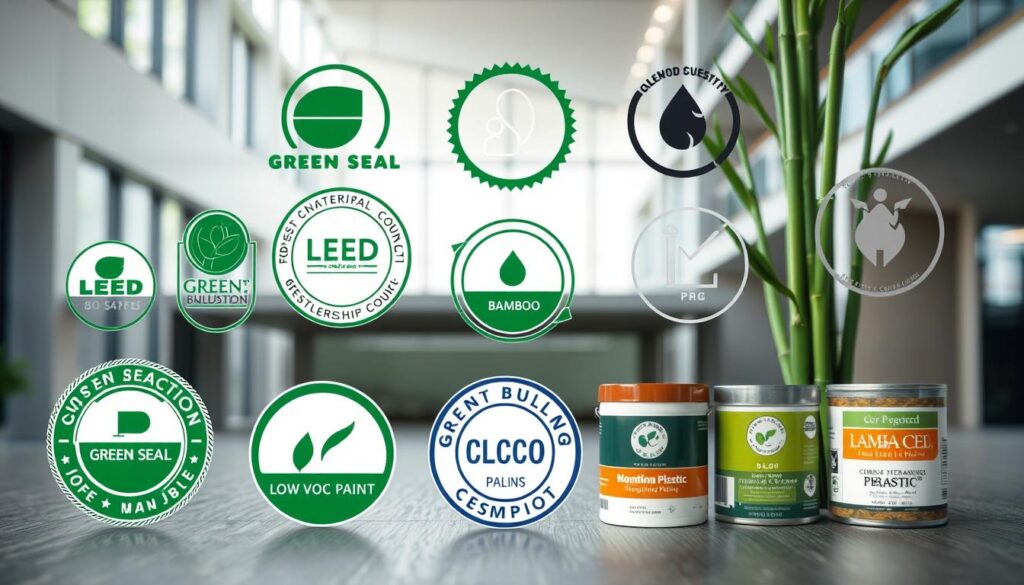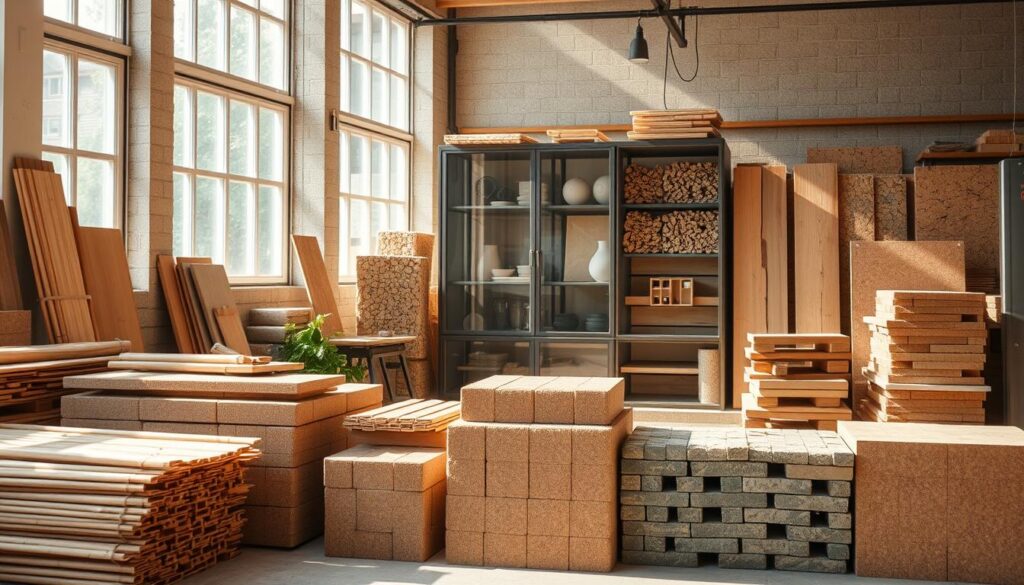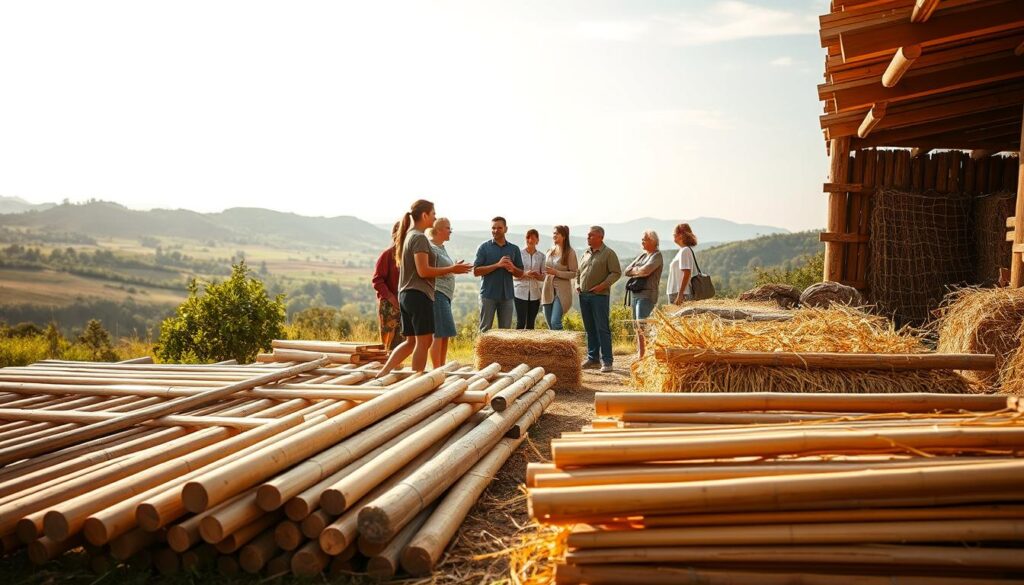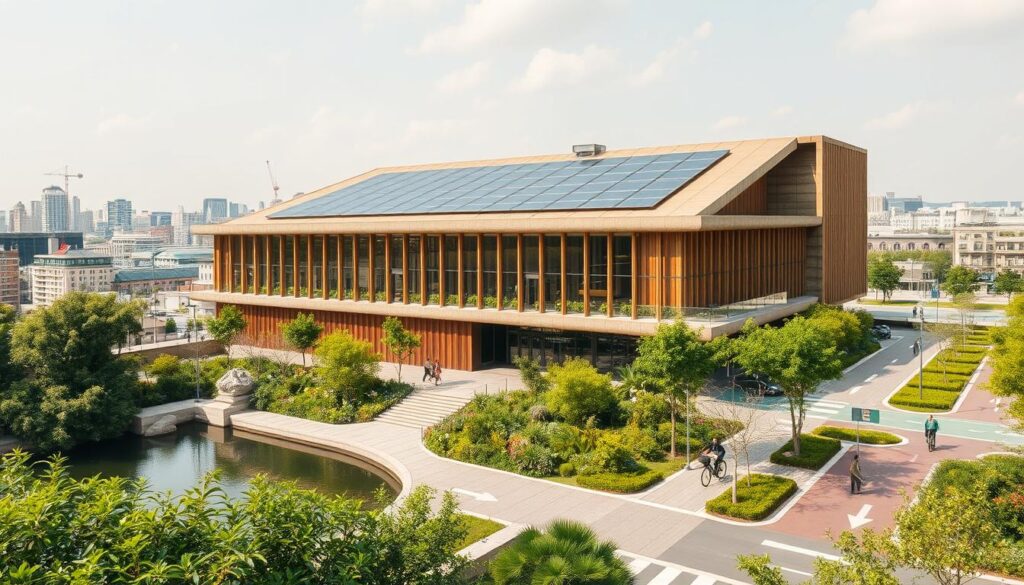Are traditional construction methods holding us back from creating a greener future? As the world shifts towards more eco-friendly practices, the construction industry is under increasing pressure to adopt innovative solutions.
The use of eco-friendly building materials is becoming a crucial aspect of civil projects, not only for reducing environmental impact but also for creating more durable and efficient structures.
As we explore the various options available, it becomes clear that the future of construction lies in embracing sustainable practices.
Key Takeaways
- Eco-friendly materials reduce environmental impact.
- Innovative materials enhance durability and efficiency.
- Sustainable practices are crucial for the future of construction.
- Eco-friendly building materials are becoming increasingly popular.
- The construction industry is shifting towards greener methods.
The Importance of Sustainable Building Materials
As the world grapples with environmental challenges, the importance of sustainable building materials cannot be overstated. The construction industry is one of the largest consumers of natural resources and a significant contributor to greenhouse gas emissions. Therefore, adopting sustainable practices in construction is crucial for reducing the environmental footprint.
What Are Sustainable Building Materials?
Sustainable building materials are those that are sourced and used in ways that minimize their impact on the environment. These materials are typically characterized by their ability to reduce energy consumption, lower greenhouse gas emissions, and improve indoor air quality. Examples include recycled materials, sustainably sourced wood, and low-carbon concrete alternatives.
The use of such materials not only contributes to a healthier environment but also enhances the well-being of building occupants. By choosing materials with low VOC (Volatile Organic Compound) emissions, for instance, builders can significantly improve indoor air quality.
Benefits of Using Eco-Friendly Materials
The benefits of using eco-friendly materials in construction are multifaceted. Some of the key advantages include:
- Reduced Energy Consumption: Eco-friendly materials often have better insulation properties, reducing the need for heating and cooling.
- Lower Greenhouse Gas Emissions: By using materials that are sustainably sourced or have lower embodied energy, the overall carbon footprint of a building is reduced.
- Improved Indoor Air Quality: Materials with low VOC emissions contribute to a healthier indoor environment.
- Enhanced Durability: Many sustainable materials are designed to be more durable, reducing the need for frequent repairs or replacements.
Environmental Impact of Traditional Materials
Traditional building materials can have significant environmental impacts, including deforestation, pollution, and resource depletion. For example, the production of conventional concrete is a major source of CO2 emissions, while the logging of old-growth forests for timber can lead to habitat loss and biodiversity decline.
By understanding the environmental impact of traditional materials, builders and architects can make informed decisions about material selection, opting for sustainable alternatives that minimize harm to the environment.
Types of Sustainable Building Materials
The construction industry is shifting towards sustainable building materials to reduce its environmental footprint. This shift is driven by the need to minimize the ecological impact of building projects while promoting eco-friendly practices.

Recycled Materials in Construction
Recycled materials play a significant role in sustainable construction by reducing waste and conserving natural resources. Examples include:
- Recycled glass
- Recycled metal
- Recycled plastic
These materials not only reduce the need for new raw materials but also decrease the amount of waste sent to landfills.
Bamboo: A Renewable Building Resource
Bamboo is a highly renewable resource due to its fast growth rate and excellent strength and durability. It is used in various construction applications, including:
- Structural elements
- Flooring
- Decorative features
Bamboo’s sustainability and versatility make it an attractive option for eco-friendly building projects.
Rammed Earth and Its Advantages
Rammed earth construction involves compacting soil into formwork to create walls. This method offers several advantages, including:
- Good thermal mass, reducing the need for heating and cooling
- Durability and low maintenance
- Aesthetic appeal with natural textures
Rammed earth construction is a sustainable and energy-efficient building technique.
Reclaimed Wood: Old Beauty, New Purpose
Reclaimed wood is salvaged from old buildings, barns, and other structures. It adds character to buildings while reducing the demand for new lumber. The use of reclaimed wood:
- Preserves history and craftsmanship
- Reduces waste and the environmental impact of new wood production
- Adds unique aesthetic value to construction projects
Reclaimed wood is a sustainable choice that combines environmental benefits with distinctive design elements.
Innovations in Sustainable Materials
The future of construction is being shaped by eco-conscious building supplies and sustainable infrastructure materials. As the industry continues to evolve, it’s embracing new materials that not only reduce environmental impact but also offer improved performance and efficiency.
Bioplastics: The Future of Construction
Bioplastics are emerging as a revolutionary material in the construction sector. Made from renewable biomass sources such as corn starch, sugarcane, or potato starch, bioplastics offer a biodegradable alternative to traditional plastics. This shift towards bioplastics can significantly reduce the carbon footprint associated with plastic production.
- Biodegradability: Bioplastics can decompose much faster than conventional plastics, reducing landfill waste.
- Renewable Resources: The use of biomass sources makes bioplastics a more sustainable option.
- Versatility: Bioplastics can be engineered to have various properties, making them suitable for a wide range of construction applications.
Aerogel: Lightweight and Insulation Properties
Aerogel is another innovative material that is gaining traction in the construction industry. Known for its exceptional insulation properties and lightweight nature, aerogel is being used to improve energy efficiency in buildings.
Key Benefits of Aerogel:
- Excellent thermal insulation, reducing energy consumption.
- Lightweight, making it easier to handle and transport.
- Highly customizable, allowing it to be used in various construction elements.
Low-Carbon Concrete Alternatives
Traditional concrete is a significant contributor to greenhouse gas emissions due to the high carbon content in cement. Low-carbon concrete alternatives are being developed to address this issue. These alternatives include supplementary cementitious materials (SCMs) and innovative mixes that reduce the amount of cement required.
Some of the promising low-carbon concrete alternatives include:
- Using industrial by-products like fly ash and slag as SCMs.
- Developing concrete mixes that utilize less cement.
- Incorporating recycled materials into concrete production.
By adopting these innovative materials, the construction industry can significantly reduce its environmental footprint while advancing towards more sustainable infrastructure.
Certifications and Standards
Certifications and standards play a crucial role in the adoption of green construction materials, promoting environmentally responsible building practices. These frameworks help ensure that materials meet specific sustainability criteria, making it easier for builders and architects to make informed decisions.

LEED Certification: What You Need to Know
LEED (Leadership in Energy and Environmental Design) Certification is a widely recognized standard for green buildings. It provides a framework for designing, constructing, and operating buildings that are environmentally friendly and sustainable. To achieve LEED certification, projects must meet certain prerequisites and earn a sufficient number of points across various categories, including energy efficiency, water usage, and material selection.
The benefits of LEED certification include increased energy efficiency, reduced water consumption, and improved indoor air quality. Moreover, LEED-certified buildings often have higher property values and can command higher rental rates.
Living Building Challenge
The Living Building Challenge is another rigorous standard that pushes the boundaries of sustainability in construction. It requires buildings to be designed and constructed to function as sustainably as a living organism. The challenge involves meeting 20 performance requirements, known as “Petals,” which are grouped into seven categories: Site, Water, Energy, Health, Materials, Equity, and Beauty.
Projects that achieve Living Building Challenge certification serve as examples of best practices in sustainable construction, showcasing innovative solutions and materials that minimize environmental impact.
FSC Certification for Wood Products
FSC (Forest Stewardship Council) Certification ensures that wood products are sourced responsibly, promoting sustainable forestry practices. FSC-certified wood comes from forests that are managed to meet strict environmental and social standards, including reforestation and habitat preservation.
By choosing FSC-certified wood products, builders and consumers can support responsible forestry practices, reducing the environmental footprint of their projects.
The Role of Local Sourcing
Sustainable civil engineering solutions often begin with the choice of locally sourced materials. This approach has gained significant attention in recent years due to its potential to reduce environmental impact while supporting local economies.
Advantages of Local vs. Imported Materials
Locally sourced materials offer several advantages over imported materials, including reduced transportation costs and lower carbon emissions. By choosing local materials, construction projects can minimize their reliance on lengthy supply chains, thereby decreasing the overall carbon footprint.
One of the key sustainable civil engineering solutions is the adoption of local sourcing practices. This not only helps in reducing the environmental impact associated with transportation but also promotes the use of local resources, enhancing the project’s sustainability.
- Reduced transportation emissions
- Lower costs due to shorter supply chains
- Support for local industries and economies
Supporting the Local Economy through Sourcing
Local sourcing plays a crucial role in supporting the local economy by creating demand for locally produced goods and services. This, in turn, can lead to job creation and economic growth within the community.
“Investing in local materials is not just an economic decision; it’s a commitment to the community’s future.”
This approach not only supports local economies but also contributes to sustainable civil engineering solutions by fostering a more resilient and localized construction industry.
| Economic Benefits | Environmental Benefits |
|---|---|
| Job creation | Reduced carbon footprint |
| Local economic growth | Lower transportation costs |
Reducing Carbon Footprint with Local Materials
The transportation of materials is a significant contributor to the carbon footprint of construction projects. By sourcing materials locally, projects can significantly reduce their environmental impact.
According to recent studies, local sourcing can reduce transportation-related emissions by up to 50%. This makes it a critical strategy for projects aiming to achieve sustainability goals.
Key benefits of local sourcing include:
- Reduced emissions
- Lower energy consumption
- Enhanced sustainability
Integrating Sustainable Materials in Design
Incorporating sustainable building materials into design is a critical step towards eco-friendly construction. This approach not only reduces the environmental footprint of buildings but also enhances their durability and energy efficiency.
Sustainable Design Principles
Sustainable design principles focus on minimizing the impact of buildings on the environment. This involves selecting materials that are recycled, recyclable, or sustainably sourced. Eco-friendly materials such as bamboo, reclaimed wood, and low-carbon concrete are gaining popularity due to their reduced environmental impact.
The key principles include:
- Using materials with low embodied energy
- Selecting materials that are durable and require less maintenance
- Incorporating materials that improve indoor air quality

Case Studies of Successful Integrations
Several projects have successfully integrated sustainable materials into their design. For instance, the use of reclaimed wood in building facades not only adds aesthetic value but also reduces waste. Another example is the application of low-carbon concrete, which significantly reduces the carbon footprint of construction projects.
| Project | Material Used | Environmental Benefit |
|---|---|---|
| Green Building Initiative | Reclaimed Wood | Reduced waste and carbon footprint |
| Eco-Friendly Housing | Low-Carbon Concrete | Significant reduction in CO2 emissions |
| Sustainable Office Complex | Bamboo | Renewable resource, fast growth rate |
Tools for Sustainable Material Selection
Several tools are available to help architects and engineers select sustainable materials. These include environmental product declarations (EPDs), life cycle assessment (LCA) tools, and material databases that provide information on the sustainability of various materials.
Using these tools, professionals can make informed decisions that balance cost, performance, and sustainability. For example, LCA tools help in evaluating the environmental impacts of materials throughout their lifecycle, from production to disposal.
Challenges of Implementing Sustainable Practices
The construction industry’s transition to eco-friendly materials is complicated by several key challenges that need to be addressed. While the benefits of sustainable building practices are well-documented, the path to widespread adoption is fraught with obstacles.
Cost Considerations
One of the primary challenges is the higher upfront cost associated with eco-friendly construction materials. Although these materials often lead to long-term savings through reduced energy consumption and lower maintenance costs, the initial investment can be a significant barrier for many projects.
Key cost considerations include:
- Higher material costs
- Increased labor costs for specialized installation
- Potential for longer project timelines
To mitigate these costs, it’s essential to conduct thorough cost-benefit analyses and explore financing options that support sustainable construction practices.
Industry Resistance to Change
The construction industry is known for its traditional practices and resistance to change. This can make it difficult to adopt new, sustainable materials and techniques.
“The biggest barrier to change is not the technology itself, but rather the cultural and organizational changes required to adopt it.” –
Overcoming this resistance requires education and training for industry professionals, as well as incentives for adopting sustainable practices.
Education and Awareness Gaps
A significant challenge to the adoption of eco-friendly construction materials is the lack of education and awareness among industry stakeholders, including builders, architects, and clients.
Key areas for education and awareness include:
- Benefits of sustainable materials
- Proper installation and maintenance techniques
- Long-term cost savings
By addressing these challenges through education, incentives, and industry-wide collaboration, the construction industry can accelerate its transition to more sustainable practices.
Cost Benefits of Sustainable Materials
Green building materials provide a win-win situation by reducing environmental impact and offering cost savings. As the construction industry continues to evolve, the importance of sustainable materials becomes increasingly evident.

Long-term Savings on Energy and Maintenance
One of the significant advantages of using green building materials is the potential for long-term savings on energy and maintenance. Materials such as recycled insulation, low-carbon concrete, and sustainably sourced wood can significantly reduce the energy consumption of a building. For instance, a study by the U.S. Green Building Council found that buildings using sustainable materials can reduce energy consumption by up to 30%.
Moreover, sustainable materials often require less maintenance, thereby reducing the overall lifecycle costs of a building. As
“Sustainable materials not only reduce the environmental footprint but also offer economic benefits through reduced maintenance and energy costs.”
noted by experts in the field.
Tax Incentives and Grants
In addition to long-term savings, projects that incorporate green building materials can benefit from various tax incentives and grants. Governments around the world offer financial incentives to encourage the use of sustainable practices in construction. For example, in the United States, the Energy Policy Act provides tax deductions for buildings that meet certain energy efficiency standards.
- Tax credits for energy-efficient buildings
- Grants for sustainable construction projects
- Deductions for the use of renewable energy systems
Value Added Through Sustainability
The use of environmentally friendly building materials can also increase the value of a property. Buildings that are certified under programs like LEED (Leadership in Energy and Environmental Design) often command higher rental rates and sale prices due to their sustainable features. As the demand for green buildings continues to grow, incorporating sustainable materials can be a savvy business decision.
In conclusion, the cost benefits of sustainable materials are multifaceted, ranging from long-term savings on energy and maintenance to tax incentives and increased property value. By choosing green building materials, builders and property owners can contribute to a more sustainable future while also improving their bottom line.
The Future of Sustainable Materials in Civil Engineering
The future of civil engineering is being shaped by advancements in sustainable construction products. As the industry continues to evolve, it’s essential to stay ahead of the curve by embracing innovative materials and practices that not only reduce environmental impact but also enhance the durability and efficiency of civil projects.
Innovations on the Horizon
The civil engineering sector is witnessing a surge in innovative materials that promise to revolutionize the way we build. Some of these include:
- Self-healing concrete: A material that can repair cracks autonomously, potentially extending the lifespan of structures.
- Graphene-based materials: Offering enhanced strength and conductivity, these materials are poised to make a significant impact.
- Advanced insulation materials: New materials that provide better thermal insulation, reducing energy consumption.
Trends in Sustainable Construction
Sustainable construction is becoming increasingly important, driven by both regulatory requirements and consumer demand. Current trends include:
- Increased use of recycled materials: Reducing waste and the demand for new raw materials.
- Prefabricated construction: Enhancing efficiency and reducing on-site waste.
- Green building certifications: Encouraging best practices through recognized standards.
Predictions for the Next Decade
Looking ahead, the next decade is expected to see significant advancements in sustainable materials and practices. Some predictions include:
- A greater emphasis on circular economy principles in construction.
- The widespread adoption of bio-based materials.
- Increased investment in research and development for sustainable construction products.
As we move forward, it’s clear that sustainable materials will play a pivotal role in shaping the future of civil engineering. By embracing these innovations and trends, the industry can continue to grow while minimizing its environmental footprint.
Community Engagement in Sustainable Building
Sustainable building initiatives thrive when local communities are actively involved. This involvement not only fosters a sense of ownership but also ensures that the projects meet the community’s needs and expectations.

Collaborating with Local Communities
Collaborating with local communities is a vital aspect of sustainable building. It involves working closely with residents, local businesses, and community groups to understand their needs and preferences. This collaboration can lead to more effective and sustainable solutions.
For instance, a community might have specific requirements for building materials, such as the use of eco-conscious building supplies. By incorporating these requirements into the project, builders can ensure that the final product is both sustainable and appreciated by the community.
“Community engagement is not just about informing the public; it’s about involving them in the decision-making process.” –
Educational Programs on Sustainability
Educational programs play a crucial role in promoting sustainability within communities. These programs can range from workshops on sustainable building practices to educational campaigns on the benefits of eco-friendly materials.
- Workshops on sustainable building techniques
- Educational campaigns on the benefits of eco-friendly materials
- Community events promoting sustainable living
Involving Stakeholders in Decision-Making
Involving stakeholders in the decision-making process is essential for the success of sustainable building projects. This includes not only the local community but also investors, architects, and local government officials.
By engaging stakeholders early in the process, project leaders can identify potential issues and opportunities, ensuring that the project is both sustainable and viable in the long term.
Real-Life Applications of Sustainable Materials
Innovative sustainable materials are being used in groundbreaking construction projects globally. These materials are not only reducing the environmental impact of construction but also providing cost-effective solutions and improving the quality of buildings.
Notable Projects Using Eco-Friendly Materials
Several notable projects have successfully utilized eco-friendly materials, showcasing their potential in large-scale constructions. For instance, the use of recycled materials in construction has been a game-changer in reducing waste and conserving natural resources.
Examples of successful projects include:
- The construction of the Amazon Spheres in Seattle, which used reclaimed wood and other sustainable materials.
- The One Central Park development in Sydney, featuring a vertical garden and sustainable design principles.
These projects demonstrate the feasibility and benefits of incorporating sustainable infrastructure materials into construction.
Lessons Learned from Successful Builds
Analyzing successful projects reveals valuable lessons for future constructions. One key takeaway is the importance of early planning and integration of sustainable materials into the design process.
“Sustainability is not just about being green; it’s about being smart and efficient.” –
Additionally, collaboration among stakeholders, including architects, engineers, and contractors, is crucial for the successful implementation of green construction materials.
Community Projects Shaping the Future
Community-led projects are playing a significant role in promoting the use of sustainable materials. These initiatives not only raise awareness but also demonstrate the practical applications of eco-friendly materials in real-world settings.
Community projects have shown that:
| Project | Location | Impact |
|---|---|---|
| Green Building Initiative | Portland, OR | Reduced carbon footprint by 30% |
| Sustainable Homes Program | Austin, TX | Increased use of recycled materials by 25% |
These community projects are shaping the future of sustainable construction by pushing the boundaries of innovation and adoption of green construction materials.
How to Choose the Right Materials for Your Projects
The decision to use sustainable civil engineering solutions can make a significant difference in the overall success of a project. Choosing the right materials involves a thorough evaluation of their benefits and drawbacks, as well as considering their environmental impact and cost-effectiveness.

Evaluating Material Benefits and Drawbacks
When evaluating materials, it’s essential to consider their performance, durability, and environmental footprint. For instance, eco-friendly construction materials like bamboo and reclaimed wood offer excellent sustainability profiles. However, their availability and cost can vary significantly depending on the region.
A comprehensive assessment should include:
- The material’s source and production process
- Its durability and maintenance requirements
- The potential for recycling or reuse
- Its impact on indoor air quality and occupant health
Resources for Researching Sustainable Options
Several resources are available to help researchers and practitioners identify sustainable materials. These include:
- Environmental Product Declarations (EPDs) that provide transparent information on a product’s environmental impact
- Certification programs like LEED and FSC that promote sustainable forestry practices
- Industry reports and databases that catalog sustainable materials and their suppliers
Consulting Experts in Sustainable Practices
Consulting with experts in sustainable practices can provide valuable insights into the latest developments and best practices in eco-friendly construction. Experts can offer guidance on material selection, help navigate certification processes, and provide strategies for overcoming common challenges.
By combining thorough research with expert consultation, project stakeholders can make informed decisions that support their sustainability goals and contribute to a more environmentally friendly built environment.
Conclusion: The Future of Civil Engineering is Green
The future of civil engineering is undeniably green, driven by the adoption of sustainable building materials in civil engineering. As the industry continues to evolve, embracing green building materials is crucial for reducing environmental impact.
Promoting Sustainable Practices
Engineers play a critical role in promoting sustainable practices by selecting materials that minimize environmental footprint. This involves considering the lifecycle costs and benefits of green building materials.
Innovation for Sustainability
Embracing innovation is key to a sustainable future. Advances in materials science and technology are continually expanding the range of sustainable options available to engineers, enabling the creation of more efficient, durable, and environmentally friendly infrastructure.
By integrating sustainable building materials into civil engineering projects, professionals can contribute to a more sustainable future. The industry’s shift towards green building materials is not only beneficial for the environment but also enhances the long-term viability of infrastructure projects.

Pingback: Environmentally Responsible Design & Construction
Pingback: Next-Generation Building Tech Trends in the USA
Pingback: State-of-the-Art Civil Engineering Materials Innovation
Pingback: Cutting-Edge Civil Engineering Materials: Global Research Update
Pingback: Modern Civil Engineering Practices for Climate-Resilient Urban Development
Pingback: Sustainable Infrastructure Solutions for a Greener, More Resilient World
Pingback: sustainable infrastructure developmen
Pingback: sustainable infrastructure development
Pingback: How to Build Low-Carbon Infrastructure for a Sustainable Future